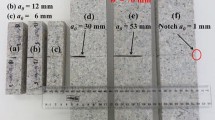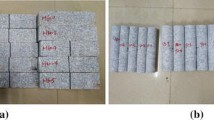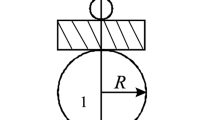Summary
This paper describes and discusses the adequacy of Weibull statistical analysis to analyse the bending strength of granite. The experimental results show that strength variability is related with a specific origin of failure. This conclusion is based on analysing the influence of the surface condition (extrinsic defects) on the bending strength results treated by the Weibull statistics. The conclusions drawn from this study have been validated by analysing the results of the critical flaw dimension estimated by applying the linear elastic fracture mechanics (LEFM) formulae. Results obtained from fractographic examination also have been used to describe the location of the origin of the fracture and understand the distribution of defects; i.e., there is a unimodal distribution of defects (intrinsic defects), despite the fact that some outlier values are normally observed in the fractured surfaces.
Similar content being viewed by others
References
Amaral PM (2004) Mechanical behaviour of ornamental stones. Doctor Thesis in Materials Engineering, Technical University of Lisbon, Lisbon
PM Amaral et al. (1999) ArticleTitleFracture toughness of different types of granite Int J Rock Mech Min Sci 36 839–842 Occurrence Handle10.1016/S0148-9062(99)00041-8
P Blasi et al. (2000) ArticleTitleAn experimental investigation on marble testing for bending strength RocMaquina 38 20–25
Casal Moura A (2000) Granitos e Rochas Similares de Portugal, ed. I.G.e. Mineiro, Porto
Cruz Fernandes J (1994) Fracture and Fatigue mechanical characterisation of structural ceramics. Doctor Thesis in Materials Engineering, Technical University of Lisbon, Lisbon
R Danzer (1992) ArticleTitleA general strength distribution function for brittle materials J Eur Ceram Soc 10 461–472 Occurrence Handle10.1016/0955-2219(92)90021-5
EN 843-5 (2006) Advanced technical ceramics – monolithic ceramics – mechanical tests at room temperature – Part 5: Statistical analysis
EN 12504-1 (2000) Testing concrete in structures – Part 1: Cored specimens – taking, examining and testing in compression
SL Fok J Smart (1995) ArticleTitleThe accuracy of failure predictions based on weibull statistics J Eur Ceram Soc 15 905–908 Occurrence Handle10.1016/0955-2219(95)00061-X
SL Fok et al. (2001) ArticleTitleA numerical study on the application of the Weibull theory to brittle materials Engng Fract Mech 68 1171–1179 Occurrence Handle10.1016/S0013-7944(01)00022-4
DJ Green (1998) An introduction to the mechanical properties of ceramics SeriesTitleCambridge solid state science series Cambridge University Press Cambridge
L Guerra Rosa et al. (2006) ArticleTitleA method to distinguish extrinsic and intrinsic fracture-origin populations in monolithic ceramics J Eur Ceram Soc 26 3887–3895 Occurrence Handle10.1016/j.jeurceramsoc.2005.12.006
ISO 20501 (2003) Fine ceramics (advanced ceramics, advanced technical ceramics) – Weibull statistics for strength data
JC Jaeger NGW Cook (1976) Effects of size and stress gradient, in Fundamentals of rock mechanics Halsted Press Inc New York
AS Jayatilaka (1979) Fracture of engineering brittle materials Applied Science Publishers LTD London
J Mencik (1992) Strength and fracture of glass and ceramics Elsevier Amsterdam
Morrell R (1985) Handbook of properties of technical & engineering ceramics. National Physical Laboratory, London, H.M.S.O
H Peterlink (1995) ArticleTitleThe validity of Weibull estimators J Mat Sci 30 1972–1976 Occurrence Handle10.1007/BF00353020
B Pugh (1973) Friction and wear: a tribology text for students Newnes-Butterworths London
K Shin et al. (2001) ArticleTitleApplication of Weibull’s theory to estimating in situ maximum stress σH by hydrofracturing Int J Rock Mech Min Sci 38 413–420 Occurrence Handle10.1016/S1365-1609(01)00009-0
JD Sullivan PH Lauzon (1986) ArticleTitleExperimental probability estimators for Weibull plots J Mat Sci Lett 5 1245–1247 Occurrence Handle10.1007/BF01729379
W Weibull (1939) ArticleTitleThe phenomenon of rupture in solids Ingeniorsvetenskapsakademiens Handlingar 151 and 153 1–55
W Weibull (1951) ArticleTitleA statistical distribution function of wide applicability J App Mech 18 293–297
H Xie F Gao (2000) ArticleTitleThe mechanics of cracks and a statistical strength theory for rocks Int J Rock Mech Min Sci 37 477–488 Occurrence Handle10.1016/S1365-1609(99)00074-X
Author information
Authors and Affiliations
Additional information
Correspndence: P. M. Amaral, Department of Materials Engineering, Instituto Superior Técnico, Technical University of Lisbon, Av. Rovisco Pais, 1049-001 Lisboa, Portugal
Rights and permissions
About this article
Cite this article
Amaral, P., Cruz Fernandes, J. & Guerra Rosa, L. Weibull statistical analysis of granite bending strength. Rock Mech Rock Eng 41, 917–928 (2008). https://doi.org/10.1007/s00603-007-0154-7
Received:
Accepted:
Published:
Issue Date:
DOI: https://doi.org/10.1007/s00603-007-0154-7




